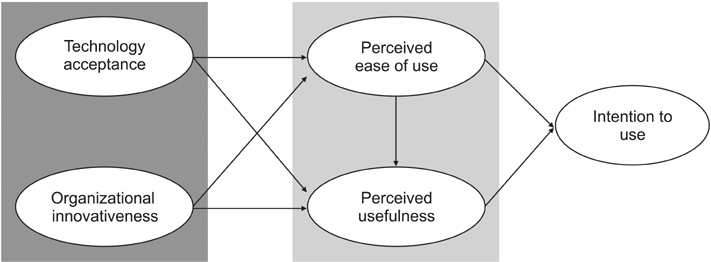Healthc Inform Res.
2016 Oct;22(4):342-350. 10.4258/hir.2016.22.4.342.
Medical Representatives' Intention to Use Information Technology in Pharmaceutical Marketing
- Affiliations
-
- 1Department of Health Services Management, Graduate School, Kyung Hee University, Seoul, Korea.
- 2School of Management, Kyung Hee University, Seoul, Korea. hjchang@khu.ac.kr
- KMID: 2357389
- DOI: http://doi.org/10.4258/hir.2016.22.4.342
Abstract
OBJECTIVES
Electronic detailing (e-detailing), the use of electronic devices to facilitate sales presentations to physicians, has been adopted and expanded in the pharmaceutical industry. To maximize the potential outcome of e-detailing, it is important to understand medical representatives (MRs)' behavior and attitude to e-detailing. This study investigates how information technology devices such as laptop computers and tablet PCs are utilized in pharmaceutical marketing, and it analyzes the factors influencing MRs' intention to use devices.
METHODS
This study has adopted and modified the theory of Roger's diffusion of innovation model and the technology acceptance model. To test the model empirically, a questionnaire survey was conducted with 221 MRs who were working in three multinational or eleven domestic pharmaceutical companies in Korea.
RESULTS
Overall, 28% and 35% of MRs experienced using laptop computers and tablet PCs in pharmaceutical marketing, respectively. However, the rates were different across different groups of MRs, categorized by age, education level, position, and career. The results showed that MRs' intention to use information technology devices was significantly influenced by perceived usefulness in general. Perceived ease of use, organizational and individual innovativeness, and several MR characteristics were also found to have significant impacts.
CONCLUSIONS
This study provides timely information about e-detailing devices to marketing managers and policy makers in the pharmaceutical industry for successful marketing strategy development by understanding the needs of MRs' intention to use information technology. Further in-depth study should be conducted to understand obstacles and limitations and to improve the strategies for better marketing tools.
MeSH Terms
Figure
Cited by 2 articles
-
Satisfaction with Paper-Based Dental Records and Perception of Electronic Dental Records among Dental Professionals in Myanmar
Sai Wai Yan Myint Thu, Boonchai Kijsanayotin, Jaranit Kaewkungwal, Ngamphol Soonthornworasiri, Wirichada Pan-ngum
Healthc Inform Res. 2017;23(4):304-313. doi: 10.4258/hir.2017.23.4.304.Medical Representatives’ User Acceptance of Remote e-Detailing Technology: A Moderated Mediation Analysis of Technology Acceptance Model
Hyun Woo Kim, Hyejung Chang
Healthc Inform Res. 2022;28(1):68-76. doi: 10.4258/hir.2022.28.1.68.
Reference
-
1. Gleason M. Internet detailing opens the doctor's door. Med Mark Media. 2001; 36(1):80–86.2. Davidson T, Sivadas E. Details drive success: physicians are responding to electronics sales calls. Mark Health Serv. 2004; 24(1):20–25.3. Alkhateeb FM. Physicians' attitudes toward e-detailing: a pilot study. Value Health. 2007; 10(3):A34.4. Molloy W, Strang D, Guyatt G, Lexchin J, Bedard M, Dubois S, et al. Assessing the quality of drug detailing. J Clin Epidemiol. 2002; 55(8):825–832.
Article5. Montoya ID. E-detailing: information technology applied to pharmaceutical detailing. Expert Opin Drug Saf. 2008; 7(6):635–641.
Article6. Ventura K, Baybars M, Dedeoglu AO. A new debate for Turkish physicians: e-detailing. Health Mark Q. 2012; 29(4):362–377.
Article7. Bates A, Bailey E, Rajyaguru I. Navigating the e-detailing maze. Int J Med Mark. 2002; 2(3):255–262.
Article8. McKillen D. E-detailing gaining acceptance among physician. Med Mark Media. 2002; 37(9):10–12.9. Davidson T. eDetailing: an alternative sales detail. Rutgers Bus Sch Newsl. 2004; 1:1–8.10. Boehm EW, Brown EG, Molvar K. Pharma's detailing overhaul. Cambridge (MA): Forrester Research Inc.;2001.11. Alkhateeb FM, Doucette WR. Influences on physicians' adoption of electronic detailing (e-detailing). Inform Health Soc Care. 2009; 34(1):39–52.
Article12. Gonul FF, Carter FJ. Impact of e-detailing on the number of new prescriptions. Health Care Manag Sci. 2010; 13(2):101–111.
Article13. Rasmussen R, Mylonas A, Beck H. Business communication and technologies in a changing world. South Yarra, Australia: Macmillan Education Australia;2009.14. Rogers EM. Diffusion of innovations. 5th ed. New York (NY): Free Press;2003.15. Davis FD. Perceived usefulness, perceived ease of use, and user acceptance of information technology. MIS Q. 1989; 13(3):319–339.
Article16. Jeon E, Park HA. Factors affecting acceptance of smartphone application for management of obesity. Healthc Inform Res. 2015; 21(2):74–82.
Article17. Yoh EA, Park KH, Kim MY. The effect of market orientation and learning orientation on business performance in the textile firms: focusing on moderating effect of company innovativeness. J Korean Soc Clothing Ind. 2008; 10(1):40–49.18. Agarwal R, Prasad J. A conceptual and operation definition of personal innovativeness in the domain of information technology. Inf Syst Res. 1998; 9(2):204–215.
Article19. Moon BC, Chang H. Technology acceptance and adoption of innovative smartphone uses among hospital employees. Healthc Inform Res. 2014; 20(4):304–312.
Article20. Dearman D, Pierce JS. It's on my other computer!: computing with multiple devices. In : Proceedings of the SIGCHI Conference on Human factors in Computing Systems; 2008 Apr 5-10; Florence, Italy. p. 767–776.21. Kim GJ. A study on acceptance factor of digital multimedia broadcasting. Korean J Journal Commun Stud. 2009; 53(3):296–323.22. Park ES, Woo HJ. A study on factors affecting the intention to use personal cloud service: focused on the convergence model of TAM and PMT. J Cybercommunication. 2013; 30(2):111–150.23. Heo SJ, Cho CH, Kim JY. Advertising implications of beacon technology: focusing on TAM to predict user acceptance of beacon application. Korean J Advert Pub Relat. 2015; 17(3):98–137.
Article24. Zahra SA, Covin JG. Contextual influences on the corporate entrepreneurship-performance relationship: a longitudinal analysis. J Bus Ventur. 1995; 10(1):43–58.
Article25. Oh KY, Cruickshank D, Anderson AR. The adoption of e-trade innovations by Korean small and medium sized firms. Technovation. 2009; 29(2):110–121.
Article26. Bagozzi RP, Baumgartner H, Yi Y. State versus action orientation and the theory of reasoned action: an application to coupon usage. J Consum Res. 1992; 18(4):505–518.
Article
- Full Text Links
- Actions
-
Cited
- CITED
-
- Close
- Share
- Similar articles
-
- Medical Representatives’ User Acceptance of Remote e-Detailing Technology: A Moderated Mediation Analysis of Technology Acceptance Model
- Evidence-based Evaluation of Information Provided by Pharmaceutical Representatives
- Influence of Hospital Website Attributes on the Recommendation of Customers in Mid-sized Hospitals
- The Understanding of, and Attitude towards Bakery Food Labeling and Their Effects on Consumer Purchase Intention - The Moderating Role of Health Consciousness -
- Influence of consumer innovativeness and cosmetic selection attributes on purchase intention of eco-friendly cosmetics


